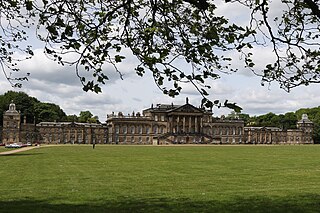
Wentworth Woodhouse is a Grade I listed country house in the village of Wentworth, in the Metropolitan Borough of Rotherham in South Yorkshire, England. It is currently owned by the Wentworth Woodhouse Preservation Trust. The building has more than 300 rooms, with 250,000 square feet (23,000 m2) of floorspace, including 124,600 square feet (11,580 m2) of living area. It covers an area of more than 2.5 acres (1.0 ha), and is surrounded by a 180-acre (73 ha) park, and an estate of 15,000 acres (6,100 ha).

The Godolphin Arabian, also known as the Godolphin Barb, was an Arabian horse who was one of three stallions that founded the modern Thoroughbred. He was named after his best-known owner, Francis Godolphin, 2nd Earl of Godolphin.

George Stubbs was an English painter, best known for his paintings of horses. Self-trained, Stubbs learnt his skills independently from other great artists of the 18th century such as Reynolds and Gainsborough. Stubbs' output includes history paintings, but his greatest skill was in painting animals, perhaps influenced by his love and study of anatomy. His series of paintings on the theme of a lion attacking a horse are early and significant examples of the Romantic movement that emerged in the late 18th century. He enjoyed royal patronage. His painting Whistlejacket hangs in the National Gallery, London.
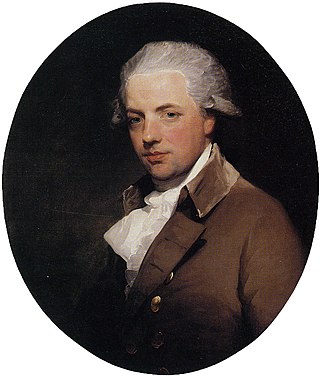
Ozias Humphry was a leading English painter of portrait miniatures, later oils and pastels, of the 18th century. He was elected to the Royal Academy in 1791, and in 1792 he was appointed Portrait Painter in Crayons to the King.

Sawrey Gilpin was an English animal painter, illustrator, and etcher who specialised in paintings of horses and dogs. He was made a Royal Academician.
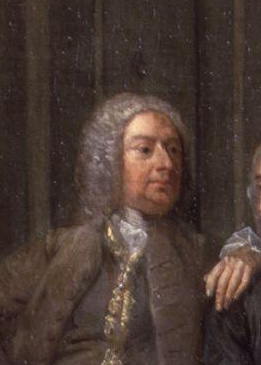
John Wootton was an English painter of sporting subjects, battle scenes and landscapes, and illustrator.

George Barret Sr. was an Irish landscape artist known for his oil paintings and watercolours. He left Ireland in 1762 to establish himself as an artist in London and quickly gained recognition to become a leading artist of the period. He exhibited at the Society of Artists of Great Britain and was able to gain patronage from many leading art collectors. Barrett with other leading members left the Society in 1768 to found the Royal Academy, where he continued to exhibit until 1782.
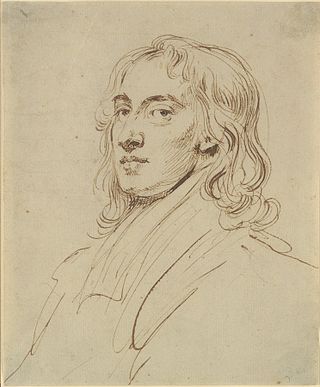
John Vanderbank was an English painter who enjoyed a high reputation during the last decade of King George I's reign and remained in high fashion in the first decade of King George II's reign. George Vertue's opinion was that only intemperance and extravagance prevented Vanderbank from being the greatest portraitist of his generation, his lifestyle bringing him into repeated financial difficulties and leading to an early death at the age of only 45.
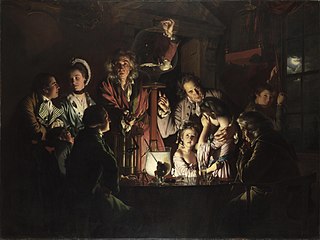
An Experiment on a Bird in the Air Pump is a 1768 oil-on-canvas painting by Joseph Wright of Derby, one of a number of candlelit scenes that Wright painted during the 1760s. The painting departed from convention of the time by depicting a scientific subject in the reverential manner formerly reserved for scenes of historical or religious significance. Wright was intimately involved in depicting the Industrial Revolution and the scientific advances of the Enlightenment. While his paintings were recognized as exceptional by his contemporaries, his provincial status and choice of subjects meant the style was never widely imitated. The picture has been owned by the National Gallery in London since 1863 and is regarded as a masterpiece of British art.
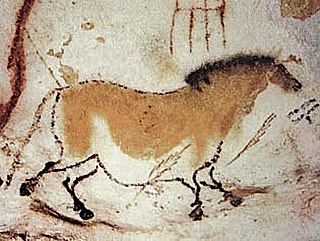
Horses have appeared in works of art throughout history, frequently as depictions of the horse in battle. The horse appears less frequently in modern art, partly because the horse is no longer significant either as a mode of transportation or as an implement of war. Most modern representations are of famous contemporary horses, artwork associated with horse racing, or artwork associated with the historic cowboy or Native American tradition of the American West. In the United Kingdom, depictions of fox hunting and nostalgic rural scenes involving horses continue to be made.
Events from the year 1762 in art.

Peter Snayers or Pieter Snayers (1592–1667) was a Flemish painter known for his panoramic battle scenes, depictions of cavalry skirmishes, attacks on villages, coaches and convoys and hunting scenes. He established his reputation mainly through his topographic battle scenes providing a bird's eye view over the battlefield. He further painted large landscapes and portraits of the aristocracy. He was a regular collaborator of local landscape painters and also Rubens.

George Clint was an English portrait painter and engraver, especially notable for his many theatrical subjects.

Charles Towne (1763–1840) was an English painter of landscapes, horses and other animals, horse-racing and hunting scenes.
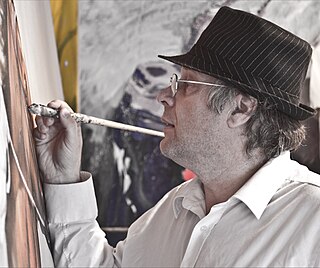
David Folley, is an English painter based in Plymouth, Devon, UK. His private studio is located in the north of the city and the public face is his gallery and studio "Discover Folley", situated in Plymouth's historic Barbican. His style of painting has been influenced by Paul Cézanne, Stanhope Forbes of the Newlyn School, Pablo Picasso, Francis Bacon, and Roger Somville, a Belgium contemporary painter. Folley's interests include "Political theory and the interactions between individual and society", colour deficiency and colour perception.

Charles I with M. de St Antoine is an oil painting on canvas by the Flemish painter Anthony van Dyck, depicting Charles I on horseback, accompanied by his riding master, Pierre Antoine Bourdon, Seigneur de St Antoine.

Richard Wright was an English marine painter. An entirely self-taught artist, he first appeared as an exhibitor in London in 1760, and between that date and 1773 exhibited twenty-five works with the Incorporated Society of Artists and one with the Free Society.

St Martin Dividing his Cloak is a painting by the Flemish painter Anthony van Dyck dated around 1618, which is an altarpiece in the Sint-Martinuskerk in Zaventem, Belgium. The painting portrays the story of Saint Martin sharing his cloak with a beggar. This early work of van Dyck was painted when he was strongly influenced by Rubens's style.

James Lynwood Palmer (1868–1941) was an English painter who specialised in painting race-horses, his characteristic style showing them as nervous and highly-strung, often depicted within a background of a dramatic landscape. His success as a leading equestrian portrait painter of the first half of the twentieth century is represented by around eight hundred paintings that were commissioned by clients, almost exclusively from private patrons, who included: William Cavendish-Bentinck, 6th Duke of Portland (1857–1943) (notably The Duke of Portland's stallions at Welbeck Stud, Daisy Greville, Countess of Warwick and King George V. He rarely exhibited his work to the public.
Géo Bernier was a Belgian painter of landscapes and portraits, but principally of horses. He was also a poster designer.





















